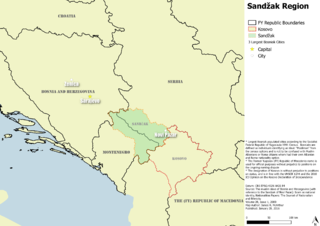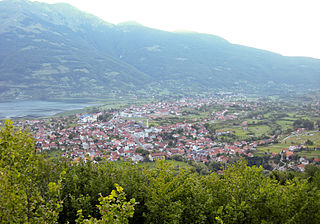
Montenegro is a country in southeast Europe on the Adriatic coast of the Balkans. It borders Bosnia and Herzegovina to the north, Serbia to the northeast, Kosovo to the east, Albania to the southeast, the Adriatic Sea and Croatia to the west. The largest and capital city Podgorica covers 10.4% of Montenegro's territory and is home to 29.9% of the country's population, while Cetinje has the status of old royal capital. Major group in the country are Montenegrins. Serbs form a significant minority at 28.7%, followed by Bosniaks, Albanians, Croats and Roma people.

Sandžak or Sanjak, is a historical geo-political region in Serbia and Montenegro. The name Sandžak derives from the Sanjak of Novi Pazar, a former Ottoman administrative district founded in 1865. Serbs refer to the northern part of the region by its medieval name Raška.
The demographic history of Montenegro can be shown through census results and official documents which mention demographic composition.

Ulcinj is a town on the southern coast of Montenegro and the capital of Ulcinj Municipality. It has an urban population of 10,707 (2011), the majority being Albanians.
Southeast Europe or Southeastern Europe (SEE) is a geographical region of Europe, consisting primarily of the coterminous Balkan Peninsula. There are overlapping and conflicting definitions as to where exactly Southeastern Europe begins or ends or how it relates to other regions of the continent. Sovereign states and territories that are included in the region are, in alphabetical order: Albania, Bosnia and Herzegovina, Bulgaria, Croatia, Greece, Kosovo, Montenegro, North Macedonia, Romania, Serbia, and East Thrace. Sometimes, Moldova and Slovenia are also included. The largest city of the region is Istanbul, followed by Bucharest, Sofia, Belgrade, and Athens.

Tuzi is a small town and seat of Tuzi Municipality, Montenegro. It is located along a main road between the city of Podgorica and the Albanian border crossing, just a few kilometers north of Lake Skadar. The Church of St. Anthony and Qazimbeg's Mosque are located in the centre of the town. Tuzi is the newest municipality in Montenegro, becoming an independent municipality since 1st September 2018.

Plav is a town in north-eastern Montenegro. It has a population of 3,717. Plav is the centre of Plav Municipality.

Rožaje is a town in northeastern Montenegro. As of 2011, the city has a population of 9,567 inhabitants.

The Catholic Church in Albania is part of the worldwide Catholic Church, under the spiritual leadership of the Pope in Rome.
Albanians in Montenegro are an ethnic group in Montenegro of Albanian descent, which constitute 4.91% of Montenegro's total population. They are the largest non-Slavic ethnic group in Montenegro.

The municipalities are the first level administrative subdivisions of Montenegro. The country is divided into 24 municipalities including the Old Royal Capital Cetinje and the Podgorica Capital City. Podgorica is divided into one subdivisions called city municipality, forming the basic level of local government.
Religion in Montenegro refers to adherents, communities, institutions and organizations of various religions in Montenegro. While Eastern Orthodox Christianity is the dominant religious denomination in Montenegro, there are also sizable numbers of adherents of both Catholic Christianity and Islam. The dominant Church is the Serbian Orthodox Church although traces of a forming Montenegrin Orthodox Church are present. According to the 2020 estimate by the Pew Research Center, 76.6% of the population is Christian, 20.3% are Muslims, and 3.1% are unaffiliated.

Languages of Montenegro are languages that are spoken in Montenegro. According to the Constitution of Montenegro, adopted in 2007, Montenegro has only one official language, specified as Montenegrin. However, at the 2011 census, 42% of the population declared Serbian to be their native language, while Montenegrin was the second most common at 37%. These are both different standardized varieties of the former Serbo-Croatian language, alongside Bosnian and Croatian. However, an official standard for Montenegrin is still in the process of being formulated. The Montenegrin language is written in Latin and Cyrillic alphabets, but there is a growing political movement to use only the Latin alphabet.

The siege of Scutari—also referred to as the siege of Shkodër, known in Turkish as İşkodra Müdafaası or İşkodra Savunması—took place from 28 October 1912 to 23 April 1913 when the army of Kingdom of Montenegro defeated the forces of the Ottoman Empire and invaded Shkodër.

Zla Kolata is a mountain of the Prokletije on the border of Montenegro and Albania.
The Albania women's national football team represents the country of Albania in international football and is controlled by the Albanian Football Association which is headquartered in the city of Tirana. The team is affiliated with UEFA and competes in the two major professional tournaments, the FIFA World Cup and the UEFA European Championship.

The Albanian revolt of 1911 or the Malësori uprising of 1911 was one of many Albanian revolts in the Ottoman Empire and lasted from 24 March 1911 until 4 August 1911 in the region of Malësia.
Montenegro participated in the Eurovision Song Contest 2012 in Baku, Azerbaijan. The Montenegrin entry was selected through an internal selection, organised by the Montenegrin broadcaster RTCG. Rambo Amadeus represented Montenegro with the song "Euro Neuro", which failed to qualify from the first semi-final, achieving 15th place with 20 points.

Adrian Lulgjuraj is an Albanian singer from Montenegro. Together with Bledar Sejko, he represented Albania in the Eurovision Song Contest 2013 in Malmö with the song "Identitet". The song failed to qualify for the final.

Vladimir is a village in the municipality of Ulcinj, Montenegro.














